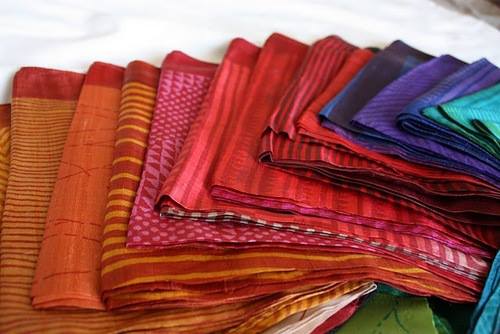THE LARGE first-floor room has never been so full: silk cloth everywhere, some of it without wrapping paper, others in cardboard boxes ready for transport. For Zia Ur Rahman, the promise that the room would be emptied evaporated long ago. Instead, what has been emptying quickly over the last five months in Nathnagar, home to Bhagalpur’s famous silk industry, are bank balances, savings accounts — and hope.
Bhagalpur is a microcosm of Bihar these days, with returning migrants, a rising Covid graph, and an economy showing signs of deep distress. The district is also the focus of a month-long assignment by The Indian Express to track how lives and livelihoods in small town India are coping with the un-lockdown.
Bhagalpur’s story is inextricably linked to its silk industry, spanning generations. Traffic signals have “Silk City” written on them, the district administrations website says “Silk City of Bihar”. The past 30 years has seen considerable decline, due to political apathy, mismanagement and the communal tension of 1989. But today, after the lockdown, it’s teetering on the edge.
Zia Ur Rahman runs one of the largest weaving units in Nathnagar, 6 km from town and home to 6,000 weaver families. He estimates that the industry was once worth Rs 500 crore, before sliding to around Rs 100 crore. “My unit produced 10,000 sq m of silk a day, earned Rs 30 lakh a month and employed 3,000 people. Now, since February, nothing…more than 95 per cent of business has collapsed,” he says.
“Silk is an expensive cloth product, and in today’s market, nobody wants to spend that money. Our demand came mostly from companies based in Europe or America. But now, with logistics a problem, and the companies struggling, there are no orders,” Rahman says.
It isn’t just that new orders aren’t coming in, he says, the old ones are being cancelled. For instance, the cloth stacked in boxes was for an order from England worth Rs 40 lakh. “There is no word from them. Orders worth Rs 80 lakh from Europe and America have been cancelled since February,” says Rahman, signalling the pandemic’s global trajectory. “On top of that, embroidery and printing happen in Delhi, Bengaluru, Surat or Varanasi, and they are all shut.”
In the lanes of Nathnagar, barely wide enough for one vehicle to pass, every window and door opens to a loom that still sits proudly in the front room. Those looms are now quiet. They made a particular sound, locals say, “Khat Kho”. Over time, that sound gave way to a word. “Khat” meant “hard work that singed the hand”. “Kho” meant “food earned from honest labour”. That social contract has been broken.
Here, Mohammad Shoaib Ansari’s small storeroom for cloth is now a grocery shop. “Earlier, I earned Rs 500-600 a day. There was no work so I opened this small shop. I sit here from 6 am to 8 pm, and earn about Rs 100 a day…nowhere near fulfilling our needs,” he says.
Yet, despite the deep distress, the romance of Bhagalpuri silk means it is always part of conversation. On May 25, Bihar Chief Minister Nitish Kumar argued for industries to set up shop in the state and assured help for returning migrants. His example of an avenue filled with opportunity? Bhagalpur silk.
Asked if the administration had any plans for revival and rescue, District Magistrate Pranav Kumar says they are “definitely looking at this sector”. “In the long term, we are looking at identifying two-three places where we will plant trees for cocoons so that there is raw material. In the short term, we have requested those who have small factories to increase work, but there are limitations. Even those that produce, they only make the cloth, stitching and branding happen outside. We will create a brand, do some stitching and then see. We will develop a cluster for those who want to work, and then create forward and backward linkages,” he says.
Rahman acknowledges that the administration has reached out. “But they want us to put money in. The question is who will buy the product? The solution, if any, is that they help us monetarily and buy the silk we produce,” he says.
About 10 km away in Bahadarpur, there is an iconic building, where the promise of reinvestment in silk, invokes skepticism. The gate of the Bihar Spun Silk Mill, a government undertaking, is ravaged by rust. The grass is wild, the building has deep cracks. Inside the gates are mangled remains of cars. A police station nearby uses its compound as a dumping yard. The mill began in 1972 before turning sick and stopping production in 1993.
And yet, Ram Narayan Bhanu turns up every day. He joined the mill in the 1970s, and was part of a workforce that grew to 370 by 1993. Since the shutdown, he says, none of them were paid their dues. Bhanu, who heads the workers’ union, says they went to court. “We had to go up to the Supreme Court, where the government admitted we were their workers, and said they would give us our dues. But we have still not been paid,” he says.
It is here, in this compound, that Bihar Industries Minister Shyam Rajak said that a new “Silk City” will be developed to provide employment. Inside the building, the walls are dark, there are no doors, only large holes in the ground where the “Japanese machines” once stood. “Before they build this new city, they must pay us our dues. They left us to live in penury. Maybe, our grandchildren will lead better lives,” says Bhanu, without any hope in his voice. The mill, like Bhagalpur’s silk, is a graveyard of broken promises.

